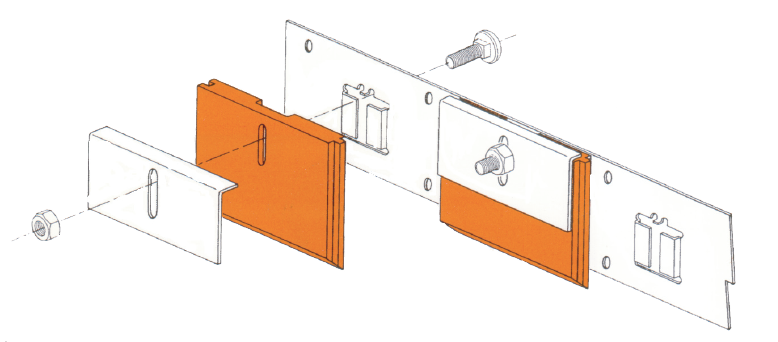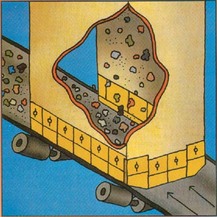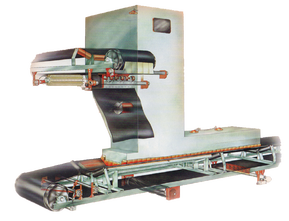
CAREX®
CONVEYOR SEALING SYSTEM
The Carex segment block system is designed to eliminate spillage where materials are loaded onto a moving belt.
Controls Spillage
With each block fully adjustable, the system can conform to any conveyor contour, preventing dust and dirt accumulating at loading and transfer points.
Tongue and grooved to form a continuous sealing strip, the blocks are held in place by vertical guide brackets on the metre long backing plates. Individual blocks can be easily replaced or adjusted when worn, providing a simple and efficient method of reducing maintenance and operating costs.

The System
Attached to the lower edge of conveyor transfer chutes, the backing plates hold the blocks firmly against the belt, with tension bolts and covering plates ensuring that their position is not altered by the movement of the conveyor. As the diagrams show, the segment blocks are fitted to the outer face of the backing plate, enabling their replacement to be a quick and simple operation.
While Carex prevents the heavy soiling of transfer points and the premature break down of expensive components, such as idlers and pulleys, the improved wear life and lower replacement and maintenance costs also help to ensure early pay back on investment.
Difficult to adjust and prone to irregular wear, continuous rubber sealing strip does not offer the flexibility, efficiency and ease of mounting and installation provided by segmented block skirting.
The system provides an effective seal with the minimum of pressure, reducing wear rates on both the belt and the blocks, which are oil and ozone resistant, manufactured from 600 to 650 shore hardness rubber and never less than 3″ softer than the conveyer itself.
With normal operating temperatures ranging from -200°C to +65°C, Carex helps maintain production-capability in some of the most demanding situations, providing solutions to established problems while forming an essential element in the design of new installations.
Installation and Maintenance
The Carex system was designed with installation, maintenance, service and performance as top priorities. Installation requirements are very simple, the old skirting is disk cut or flame cut away, with all surfaces being made good and the Carex backing plate either stitch welded or countersunk bolted in position.
Once the plate is in place and the tension bolt secured, the block and cover plate are front loaded and the tension nut tightened. The system is now ready for adjustment to the belt. This is performed via hammer blows to the covering plate, until the desired seal is achieved with the belt. To fine tune or adjust the sealing system simply tap down the appropriate blocks until the seal is complete. Care must be taken to follow all safety procedures, ie while the system is easily adjusted with the conveyor belt in operation, it is recommended that spillage areas are identified and blocks be replaced or readjusted at routine maintenance periods, when the belt is not running.
Replacement of the worn blocks is simple, via removal of the tension nut and cover plate, hand replacement of the appropriate block and replacement of the cover plate and tension nut. When completed, simply tap the block down to achieve the proper seal.
1 . Stop and isolate conveyor belt to insure against unauthorised start up.
2. Unscrew or cut off old lateral skirting system. The vertical mounting space required is 155mm.
3. Arrange the position of the Carex blocks so that they are angled towards the belt at approximately 300. The backing plate should be installed to within 1822mm of the conveyor belt. This will create a buffer chamber and so enhance the sealing properties of the Carex block. Choose the arrangement to suit the application, ie L = Light M = Medium H = Heavy.
4. At difficult access or very severe applications an additional angle piece can be attached to the top edge of the backing plate, so enabling a more aggressive angle of attack. The backing plates should be arranged in such a way that the blocks are placed directly above idlers or pulleys. If necessary shorten the first backing plate and cut back the first Carex block so that it overlaps with the next backing plate.
5. Ensure the backing plate is installed with the guide bracket pointing down.
6. Attach backing plates by either stitch welding or counter bore head screws, positioned at least every fastening and overlapping the Carex block. The backing plate may be cut to the required length by torch, saw or grinding disc.
7. To achieve the correct position of the backing plate in relation to the conveyor belt, preposition the plate by placing two blocks, one each end, between the backing plate and conveyor and preliminary tack weld or hole mark the plate.
8. In order not to damage the edge of the Carex block, initially position it so that a light contact is achieved with the belt via blows from a soft hammer. The edge of the sealing lip will wear in to provide a perfect seal.
Note: on severe applications specific contours for the blocks may be achieved via pre shaping with a sharp knife or saw. This may be aided by the use of soapy water. Also if blocks are difficult to insert the use of soapy water is recommended.
9. If the loop of the belt between idler pulleys is more than 3% of their distance the belt should be pre-tensioned or an additional idler pulley inserted.
10. Under certain circumstances the Carex blocks positioned on the front of transfer chutes should have at least 5-10mm air gap between the conveyor so that no material can heap on the outside edge.
11. Any blocks that are worn to the cover plate line should be replaced. This is easily done by releasing the tension nut and cover plate, removing the worn block and front loading the new one in position. The cover plate and tension nut are then replaced and re-tightened.
12. A week after installation the Carex system should be inspected and, if necessary, be adjusted or exchanged. After a running period of 200 hours, inspection should move to monthly intervals unless the application is very severe or spillage is deemed to be abnormal.
Caution: Working on a running conveyor belt is dangerous. The Carex system offers simple and safe adjustability but it is at no time recommended that the blocks be readjusted or replaced while a conveyor system is running.


